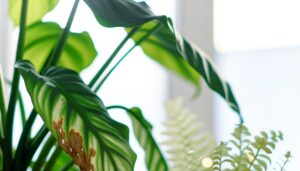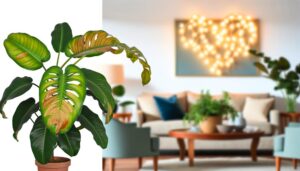What Soil Is Best for Philodendron Hederaceum?
For peak growth, Philodendron hederaceum requires a nutrient-rich potting mix composed of 40% peat moss, 30% perlite, and 30% pine bark. This blend ensures proper drainage and moisture retention.
The ideal soil pH is between 5.5 and 6.5, promoting nutrient availability. Regular monitoring and adjustment of soil pH using organic matter like compost is recommended.
Adequate drainage is vital; incorporating perlite, orchid bark, and using pots with drainage holes prevents root rot. Balanced macronutrients and trace elements are crucial for plant vigor.
Learn more to master the subtleties of perfecting Philodendron soil.
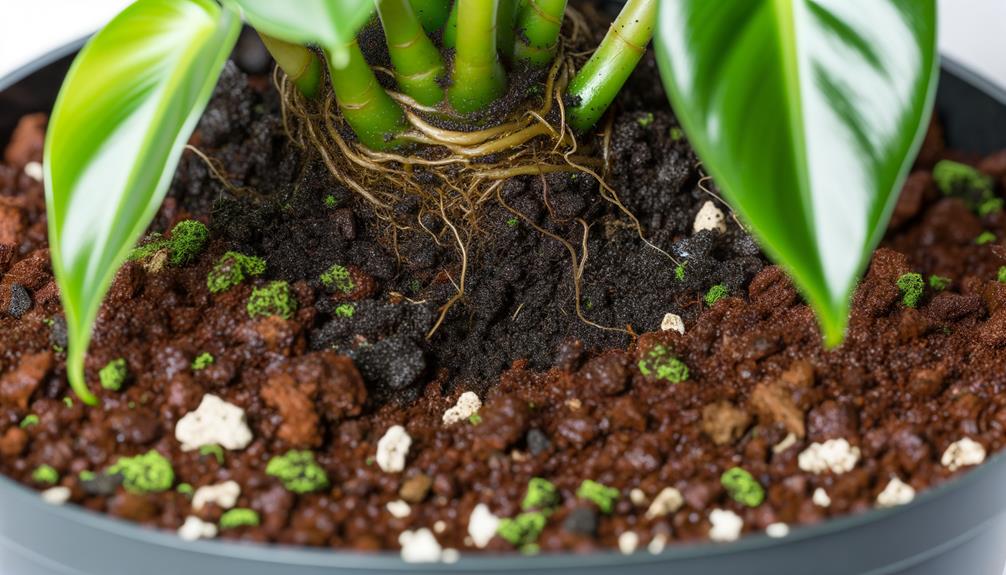
Key Takeaways
- Use a nutrient-rich potting mix with peat moss, perlite, and pine bark in a 40:30:30 ratio.
- Maintain soil pH between 5.5 and 6.5 for optimal nutrient availability.
- Ensure proper drainage by incorporating perlite, orchid bark, and coarse sand.
- Regularly refresh the soil to maintain nutrient levels and prevent deficiencies.
- Use pots with drainage holes and water only when the top inch of soil is dry.
Soil Requirements
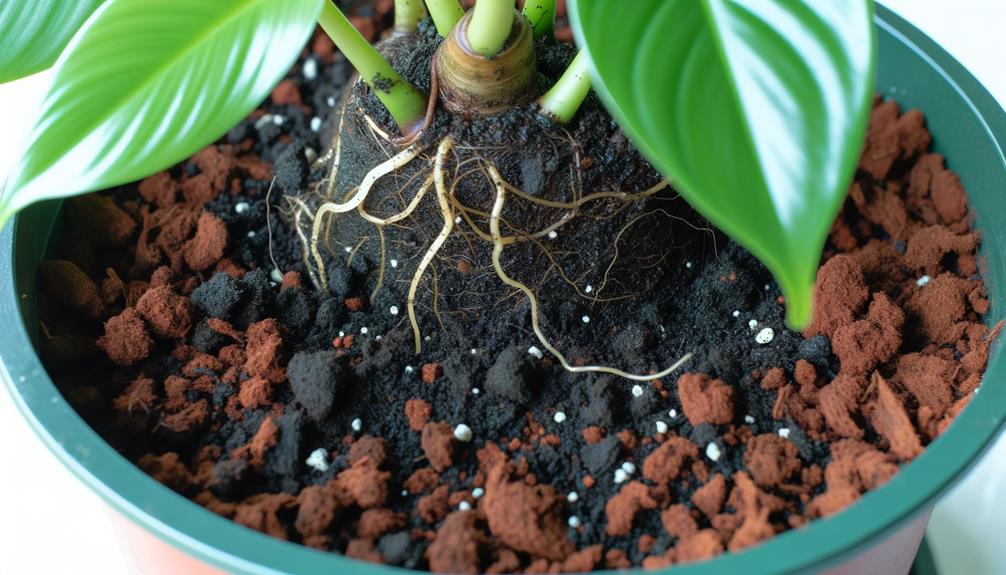
Philodendron hederaceum thrives best in a well-aerated, nutrient-rich potting mix that promotes excellent drainage and moisture retention. A high-quality mix should incorporate components such as peat moss, perlite, and pine bark.
Peat moss retains moisture while maintaining aeration, crucial for root health. Perlite, a volcanic glass, enhances drainage, preventing waterlogged conditions that can lead to root rot. Pine bark offers organic matter, enhancing nutrient availability and soil structure.
An ideal ratio for such a mix is typically 40% peat moss, 30% perlite, and 30% pine bark. This composition guarantees the balance between moisture retention and aeration, fostering robust growth and minimizing potential stressors.
Regularly refresh the soil to maintain nutrient levels and structural integrity.
Ideal Soil Ph
Maintaining an ideal soil pH of 5.5 to 6.5 is vital for ensuring the nutrient availability and overall health of Philodendron hederaceum. Within this slightly acidic range, essential nutrients such as nitrogen, phosphorus, and potassium are ideally soluble and accessible to the plant's root system.
To accurately measure the soil pH, use a dependable soil pH meter or test kit. If the pH deviates from this range, amend the soil accordingly; for instance, incorporate organic matter like compost to lower pH or add lime to raise it.
Regular monitoring and adjustment of soil pH can prevent nutrient deficiencies and promote strong growth. Always recheck pH levels after any amendments to maintain the desired range.
Drainage Needs
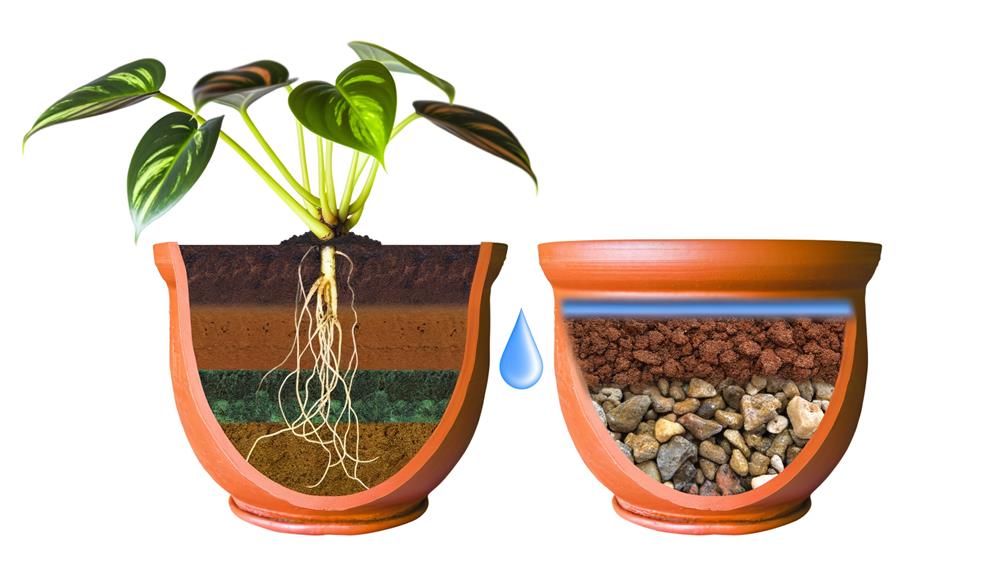
Proper drainage is crucial for Philodendron hederaceum, as it prevents root rot and other water-related issues. To achieve ideal drainage, incorporate materials such as perlite, orchid bark, and coarse sand into the soil mix.
Avoid waterlogged conditions by using pots with drainage holes and watering only when the top inch of soil feels dry to the touch.
Ensuring Proper Drainage
Ensuring sufficient drainage is crucial for the health of Philodendron hederaceum, as it prevents root rot and allows for ideal oxygen flow to the roots.
To achieve best drainage, utilize a high-porosity potting mix containing components such as perlite, orchid bark, and coarse sand. These materials enhance aeration and facilitate water movement through the substrate.
Additionally, selecting pots with ample drainage holes is imperative. Regularly monitor and adjust the soil composition to maintain structural integrity and prevent compaction over time.
Incorporating activated charcoal can further improve drainage by absorbing excess moisture and reducing soil density.
Proper drainage practices are essential for sustaining a healthy root system, ensuring robust growth and longevity for your Philodendron hederaceum.
Avoiding Waterlogged Soil
To prevent waterlogged conditions that can lead to root rot, it is vital to utilize a potting mix with a balance of organic and inorganic components crafted for optimal drainage and aeration. A well-draining substrate guarantees that excess water can escape while maintaining adequate moisture for root uptake.
Consider the following components:
- Perlite: Lightweight and porous, improves drainage and prevents compaction.
- Peat Moss: Organic substance that retains moisture while enabling air circulation.
- Pine Bark: Contributes to structural strength and aeration, reducing water retention.
- Coarse Sand: Inorganic material that fosters drainage and avoids soil clumping.
Nutrient Content
A well-balanced nutrient profile, particularly rich in nitrogen, phosphorus, and potassium, is essential for the best growth and health of Philodendron hederaceum. These macronutrients support essential physiological functions, including photosynthesis, root development, and overall vigor. In addition to macronutrients, trace elements such as magnesium, calcium, and iron are vital for preventing deficiencies and promoting lush foliage.
| Nutrient | Function | Importance |
|---|---|---|
| Nitrogen | Leaf growth and chlorophyll | High |
| Phosphorus | Root development and flowering | Moderate |
| Potassium | Disease resistance and strength | High |
| Magnesium | Chlorophyll production | Moderate |
Ensuring a nutrient-rich medium involves periodic supplementation with balanced fertilizers or organic amendments, tailored to the plant's growth stage and seasonal requirements.
Soil Mix Components
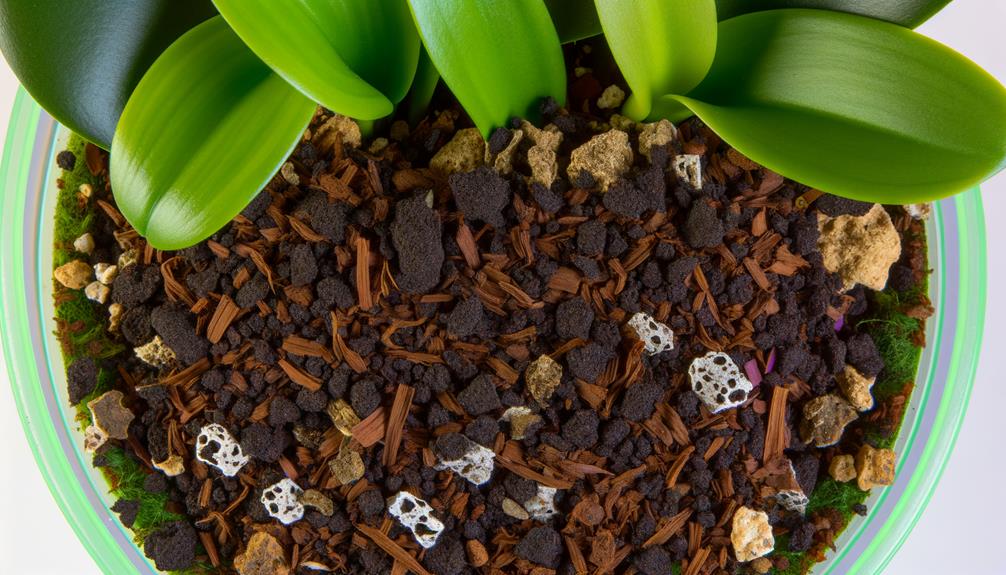
The perfect soil mix for Philodendron hederaceum should consist of necessary soil components such as peat moss, perlite, and orchid bark. Together, these components guarantee adequate aeration, moisture retention, and drainage. Achieving an ideal soil texture is essential, and a well-balanced blend will support root growth and prevent waterlogging.
Including these elements will establish an environment favorable for the plant's growth and longevity.
Essential Soil Ingredients
Best soil for Philodendron hederaceum should comprise a well-balanced mix of organic matter, aeration components, and moisture-retentive materials to guarantee proper nutrient availability and root health. Essential soil ingredients include:
- Peat Moss: Provides excellent moisture retention while supplying organic matter that supports microbial activity and nutrient availability.
- Perlite: Enhances aeration and drainage, preventing root rot by ensuring excess water can escape the root zone efficiently.
- Pine Bark Fines: Offers structure and stability to the soil mix, contributing to both aeration and slow decomposition for long-term nutrient release.
- Coconut Coir: A renewable alternative to peat, it retains moisture effectively and improves soil aeration, promoting healthy root development and preventing compaction.
These components collectively create an ideal environment for Philodendron hederaceum growth.
Optimal Soil Texture
Achieving the finest soil texture for Philodendron hederaceum involves combining specific soil mix components that balance aeration, moisture retention, and nutrient availability. A well-draining, airy mixture prevents root rot while ensuring the plant receives adequate hydration and nutrients. An ideal blend includes peat moss for moisture retention, perlite for improved aeration, orchid bark for enhanced structure, and a small portion of compost for nutrient content. These components should be mixed in precise ratios to create an excellent growing medium.
| Component | Function |
|---|---|
| Peat Moss | Moisture Retention |
| Perlite | Aeration Improvement |
| Orchid Bark | Structural Integrity |
| Compost | Nutrient Enrichment |
Common Mistakes
Overwatering often leads to root rot in Philodendron hederaceum, a mistake that can be mitigated by using well-draining soil. Ensuring the best growth conditions for this plant involves avoiding several common errors:
- Improper Soil Composition: Utilizing heavy, compact soils that retain excess moisture can suffocate the roots. Opt for a mix rich in organic matter, such as peat, perlite, and orchid bark.
- Inadequate Drainage: Failing to use pots with drainage holes prevents excess water from escaping, leading to waterlogged roots.
- Incorrect pH Levels: Philodendron hederaceum thrives in slightly acidic to neutral soil (pH 5.5-7). Deviations can impede nutrient uptake.
- Neglecting Aeration: Soil compaction over time reduces aeration. Regularly aerate the soil to maintain root health.
Adhering to these guidelines will foster a robust and healthy Philodendron hederaceum.
Conclusion
To summarize, choosing the appropriate soil substrate for Philodendron hederaceum promotes excellent growth and health.
Prioritize a porous, well-draining medium with an ideal pH range of 5.5 to 6.5.
Add organic material to enhance nutrient levels and steer clear of typical problems like compacted soil or insufficient air circulation.
A carefully combined mix of peat, perlite, and orchid bark will create the ideal conditions for this plant's requirements, supporting enduring and strong growth.

